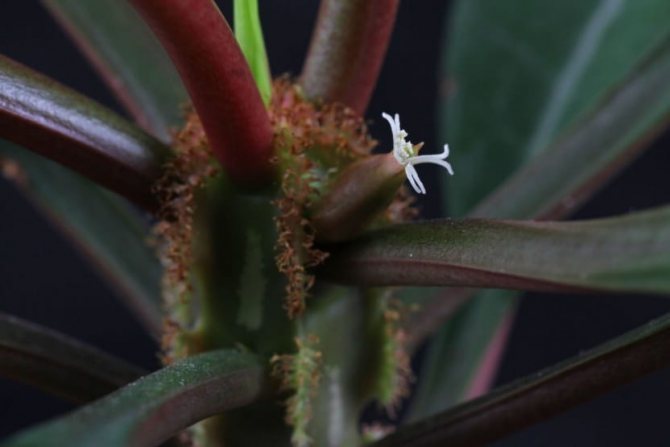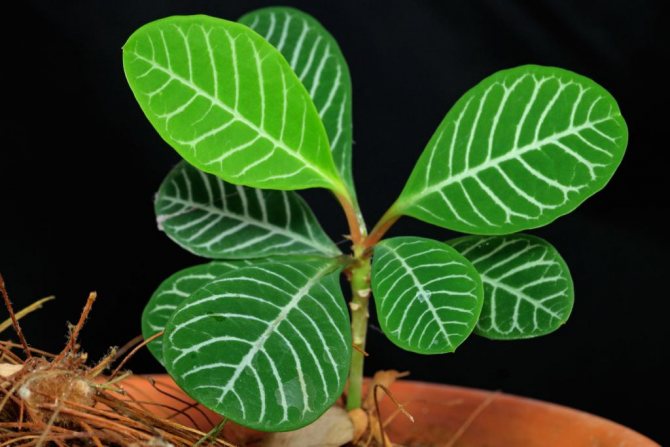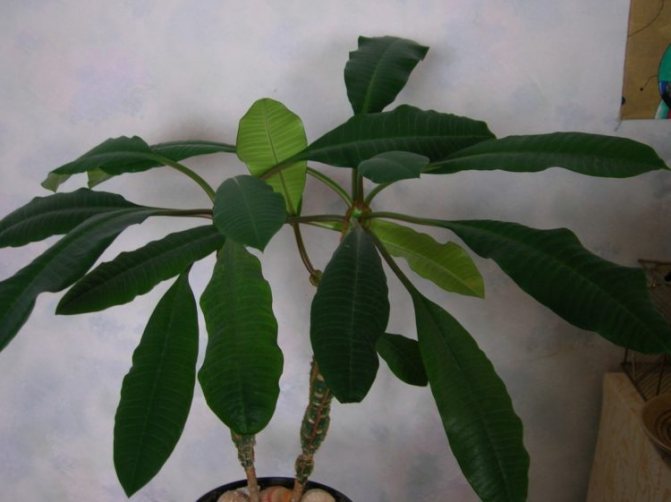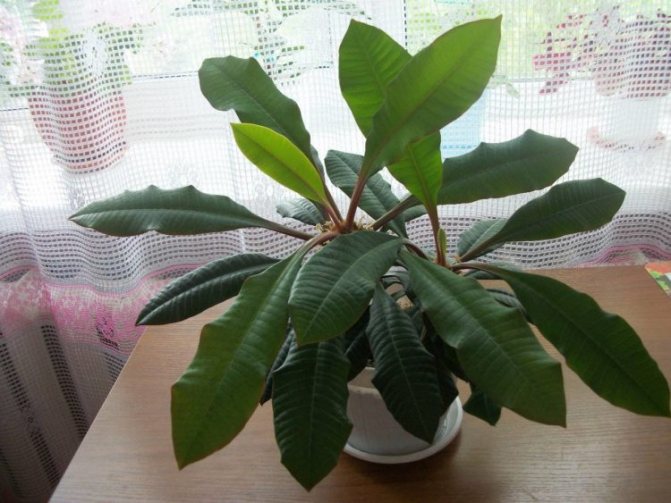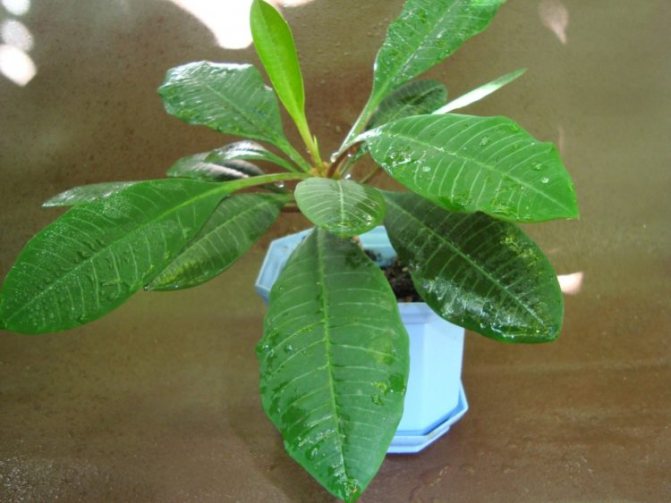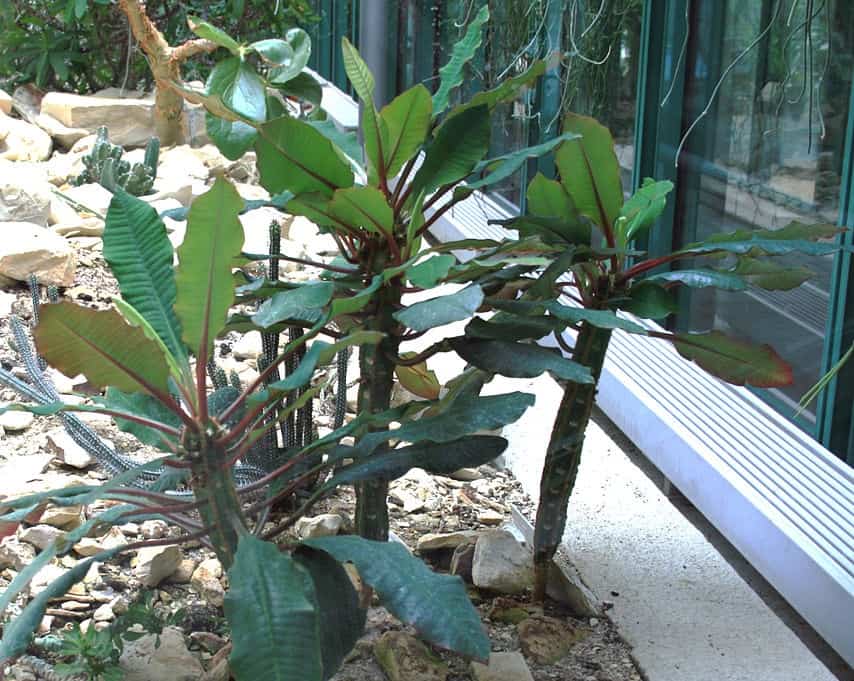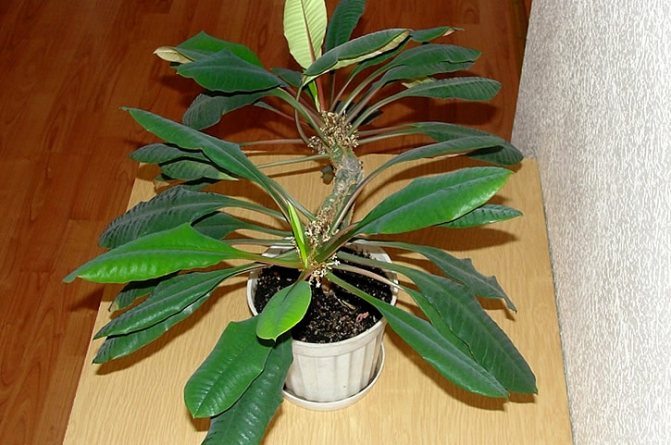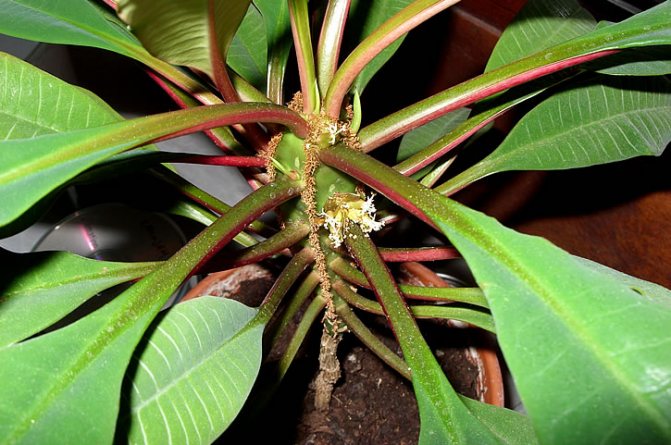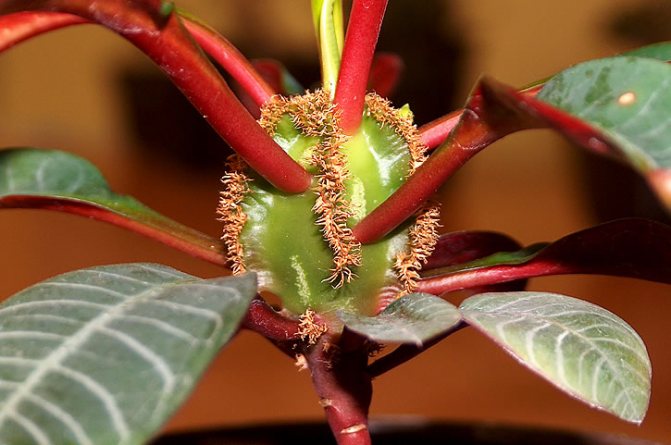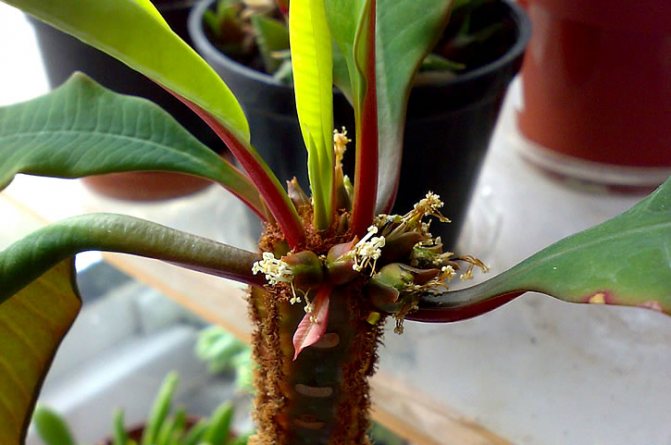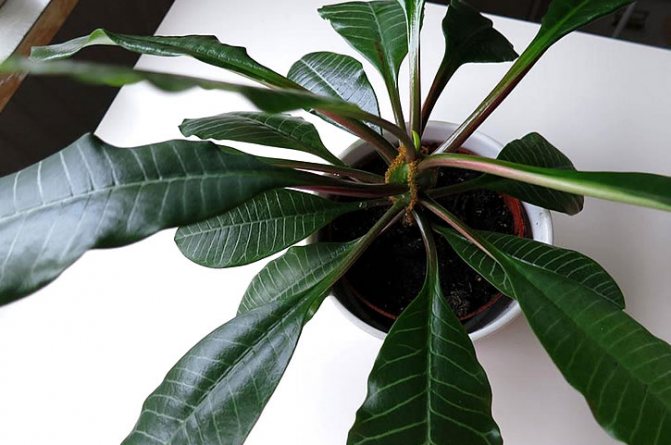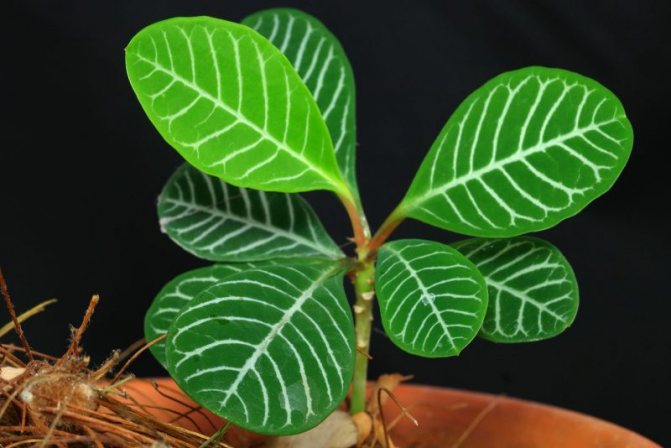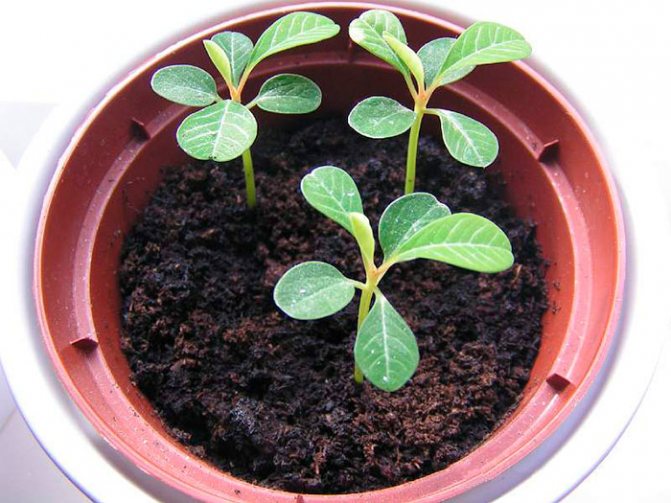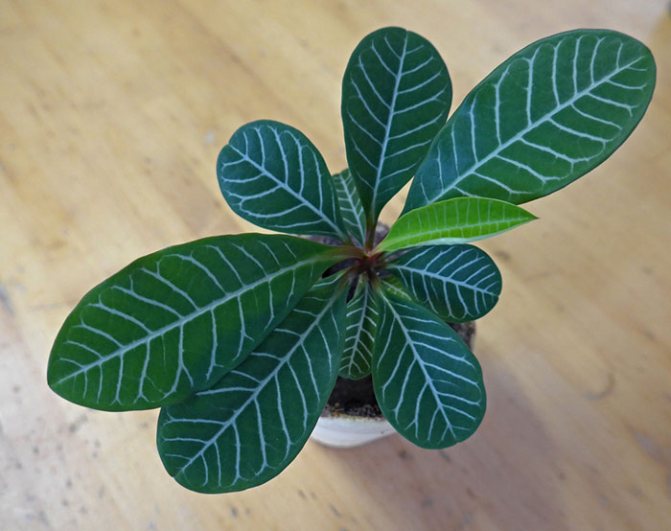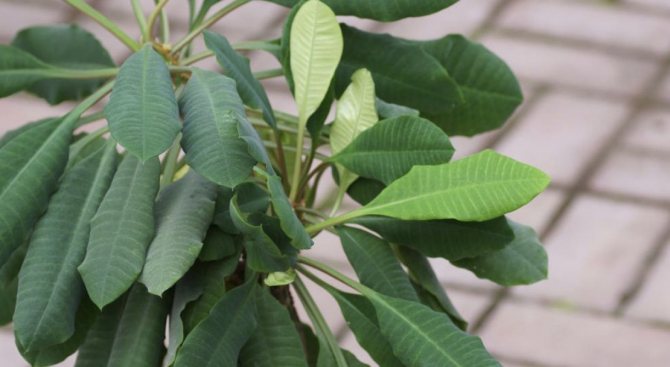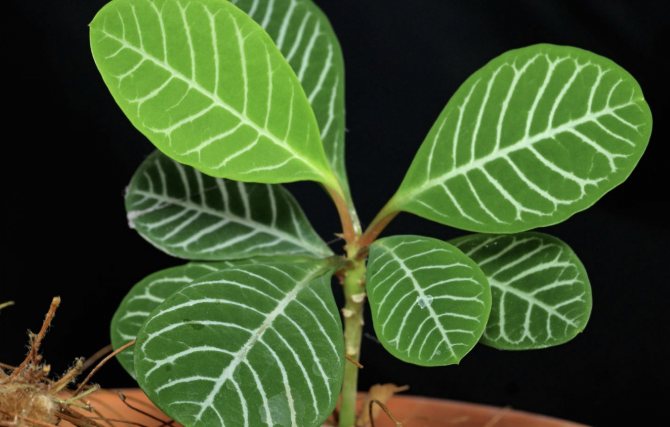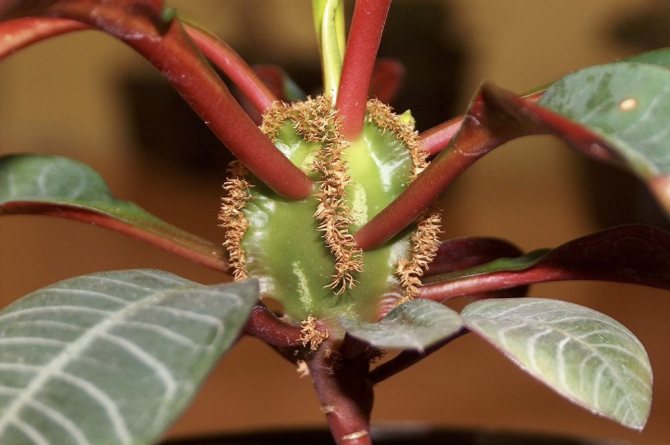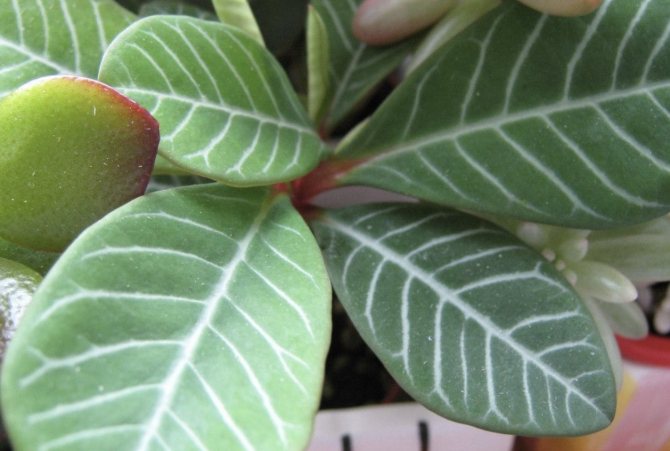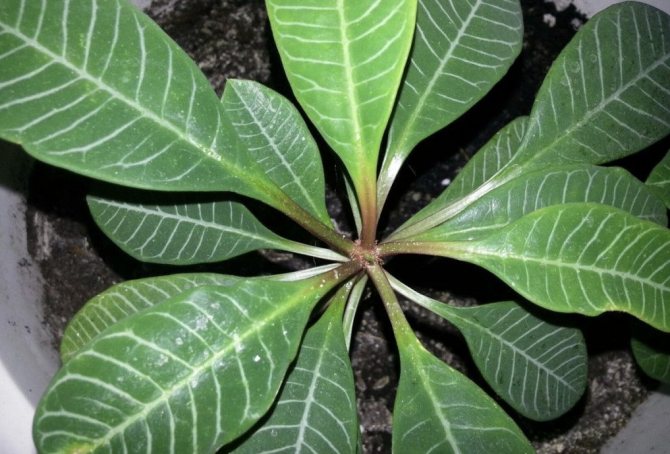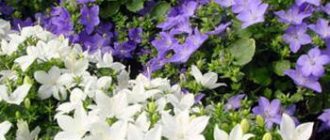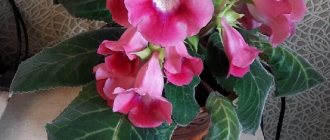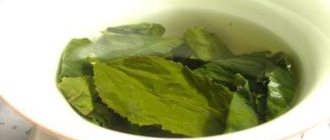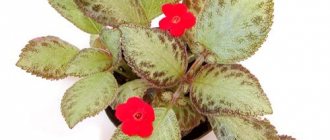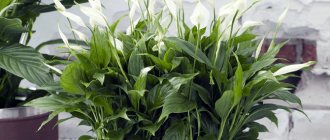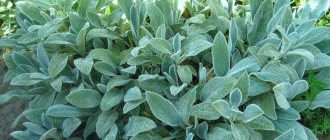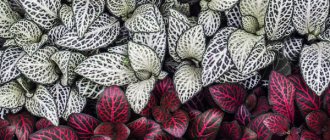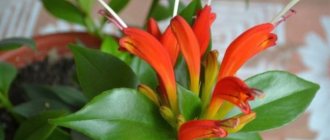Category: Houseplants
A Madagascar guest, white-tipped euphorbia today lives on almost every second windowsill, although its owners often did not decide whether they grow a cactus or a palm tree, and take care of the plant purely intuitively.

- How to care for milkweed?
- Plant propagation
- Home use and treatment
Distinctive characteristics
Biologists call this herbaceous perennial plant. Caught in favorable conditions, euphorbia can grow up to one and a half meters... A plant that has reached its maximum length is often confused with a short palm tree. A tree-like trunk and a green "sultan" of foliage at its top only enhance the resemblance.
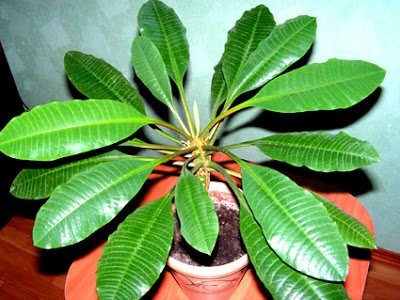

If the plant is old, its ribbed stem, dotted with small thorns, may begin to branch out, and the leaves fall off, leaving traces that resemble scars.
The dark green foliage of the white-necked milkweed sometimes reaches 15 - 25 centimeters in length. The width of the leaves of an adult plant can reach 5 centimeters, and sometimes even 8 centimeters.
The leaves of this variety of milkweed are speckled with clearly visible silvery (sometimes red) veins, and because of their glossy shine, they can be mistaken for artificial ones. The leaves are pointed at the tops and narrowed towards the base.
A whitish substance is concentrated in the stems, which flows from the plant in places of cuts or tears.
Important! Many flower growers furnish all window sills with this plant without even thinking whether it is possible to keep this culture at home. But in vain. Milkweed juice can be dangerous for humans and pets, which complicates plant care in an urban environment.
Description
This flower has many names - among the people it is most often called a banana, palm tree or cactus. It is not surprising, because the "belozhilka" came to us from sunny Madagascar.
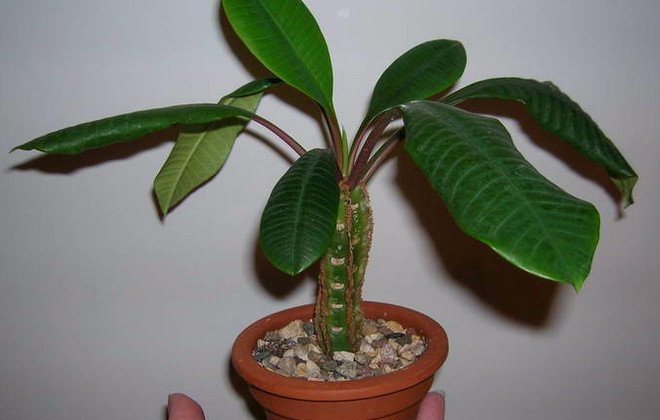

If you take a closer look at the plant, it becomes finally clear why the euphorbia received all these "nicknames".
The stem with a very dense, fleshy base is generally thin, but as it approaches the top, it begins to thicken, showing pronounced scaly ribs (which gives the resemblance to a cactus). Weak branching is occasionally observed at the apex.
Home care
During the flowering period, the spurge is covered with pale brown flowers, dotted with white stamens. The flowers of the plant appear in the axils of the apical foliage and are collected in groups of two to six pieces.
The video below contains the secrets of taking care of milkweed at home.
The fruits of the plant are in the shape of a box. Ripening, it cracks, and the seeds contained in it scatter in different directions over a sufficiently long distance (at least four meters).
Interesting! Euphorbia does not carry bad omens in the house, but according to feng shui, it is not recommended to put it in the bedroom. It is believed that the energy of the flower can negatively affect the relationship of the spouses.
Perfect soil
Spurge feels great in the soil for succulents and cacti... He himself, like them, has the ability to accumulate moisture in the stems and leaves, so he does not need regular watering.
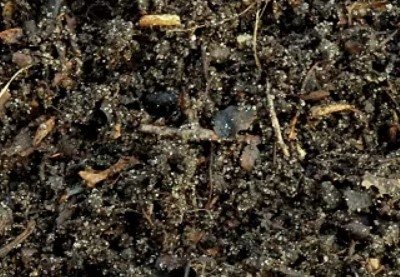

The ideal nutrient mix for growing succulents should consist of:
- leafy land;
- calcined river sand;
- peat;
- expanded clay (if desired, it can be replaced with small pebbles).
The components, taken in a proportion of 2x2x0.5x1, respectively, are mixed together, and the resulting mixture is filled into a pot.
Pot requirements
The container for this plant is taken wide and not too deep.... The use of iron and enamel dishes is strongly discouraged - in such a pot, the spurge will most likely die.
Purchase and transfer
You can transplant a succulent every year, provided that its root system has grown to such an extent that the plant has become cramped in the pot. With a systematic transplant, it is recommended each time to choose a container 1 or 2 centimeters wider than the previous one.
Variety selection
Thanks to the vigorous activity of breeders, more than 2000 plant species have been bred. Among them, 120 varieties are grown in Russia. The culture of the Euphorbia family is used in home and office floriculture. All euphorbia differ in the shape of leaves, inflorescences, but all have a milky poisonous juice.
The most common types include the following varieties:
- triangular - with a fleshy triangular stem;
- cypress - with needle-like leaves that change color during the growing season;
- white-veined - white veins are located on the leaves, from which the name originated;
- armored - narrow leaves are on an octahedral stem;
- obese - the look resembles a greenish ball and has no leaves;
- crown of thorns - has many thorns, but blooms very beautifully;
- poinsettia - pleases with scarlet flowers in December;
- the head of a jellyfish - with shoots resembling tentacles;
- palasa - has medicinal properties.
All varieties are quite unpretentious in care and are adapted for cultivation in Central Russia.
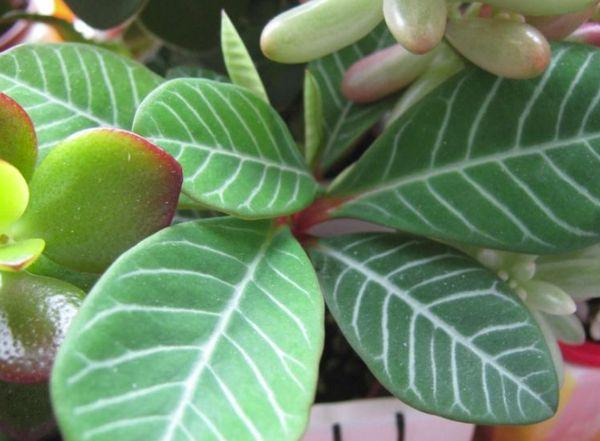

Reproduction


The plant is propagated in two ways: using cuttings and sowing seeds. Most amateur flower growers prefer to do this with the first method. It is better to schedule the procedure at the beginning of June.
Pruning and propagation by cuttings
Shoots are separated from the adult plant. Pruning is carried out at a distance of more than five centimeters. The selected shoots are immersed in a bowl with clean and slightly heated water.
A few days later (immediately after the whitish poisonous juice stops oozing from the cut site) the handle is removed from the water and the cut is rubbed with a piece of coal, thereby preventing infection of the wound with pathogenic bacteria that are abundant in the environment.
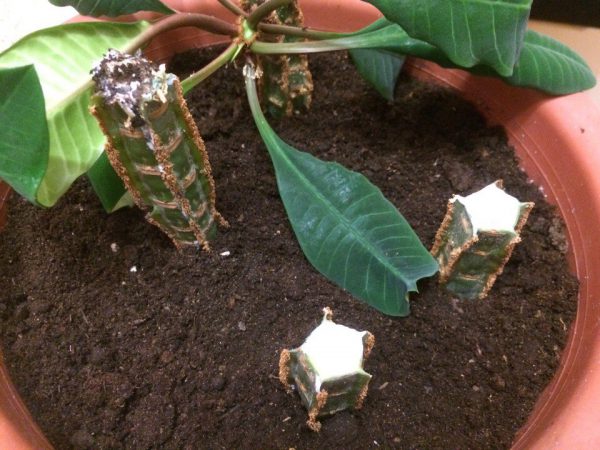

A deepening is made in the soil where it is necessary to plant the cutting. Having placed the shoot, it is sprinkled with earth, in which the milkweed sprout will have to spend at least a year, and then watered with a small amount of clean water and tamped the soil. When transplanting, make sure that the shoot is exactly in the center of the pot.
The best temperature for propagation by cuttings is –20 –25 degrees. Lovers of green spaces warn: during the first month of life in a new place, the plant should not be too disturbed. Thus, the escape will be relieved of stress.
Seed propagation
Milkweed seeds can be harvested by yourself or purchased from a flower shop. In the photo you can see how they look. The germination rate of the seeds is quite high - in a year or two of them, an adult and strong euphorbia will grow and develop. The best time for sowing is from early May to mid-April.
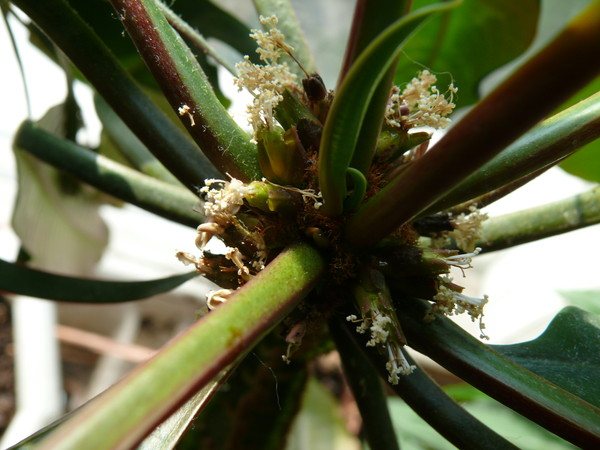

Seeds are first laid in a so-called temporary pot, to a depth of 0.5 centimeters, after loosening the soil. Watering should be moderate rather than abundant. The seed pot is placed in a cool place and forgotten for at least fourteen days.
After this time, it is transferred to a warm place so that the sprouts develop at room temperature.At least a week should pass before the first stems appear. Sprouts that have reached a height of five centimeters must be transplanted into a permanent pot.
Main problems
Euphorbia, like any plant, is also susceptible to various diseases. You can cope with many problems by reviewing the care of your culture.


The most common problems that arise are:
- The leaves begin to turn yellow, or even fall off altogether. The main cause of such metamorphoses is fungal diseases.arising under the influence of high humidity and lower ambient temperatures. One of the possible reasons why the leaves turn yellow and fall off may be the forgetfulness of the grower who did not ignite the soil before planting the plant. To get rid of this problem, the grower will have to carry out a total cleaning of the root system from the pathogenic earthen mixture, followed by its processing with a weak solution of potassium permanganate. Then the rescued plant is transplanted into a new flowerpot (the old one is thrown away).
- Falling foliage. Home care, the photo of which is presented above, implies sufficient illumination. If this is the problem with falling foliage, the question is solved simply - the plant is moved to a more illuminated corner of the apartment. If this is the only problem, the instance will recover pretty quickly.
- The main enemies of the flower are considered to be spider mites and aphids. Also, the plant can be infected with the scabbard. In this case, treatment is impossible without the use of insecticides.
How to care for milkweed?
Euphorbia does not tolerate extreme light and heat, which cacti adore so much in summer, but it will not grow in a dark place at low temperatures. For this exotic, "average" conditions should be provided, namely:
- protect from direct sunlight on a hot day, that is, prefer the western or eastern window to the southern window;
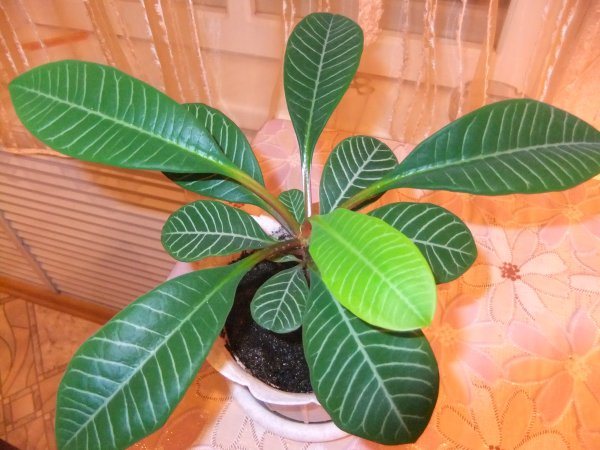

- maintain the air temperature at the level of 18-24 degrees Celsius, but not higher;
- water often in summer (every day or every other day, but not flooding), in winter in moderation, but not overdrying the soil;
- in spring and summer, feed once a month with a solution of special fertilizer for succulents;
- transplant a young plant into a larger pot once a year, and an adult once every few years.
Euphorbia is one of the few plants that is able to quickly signal its condition to you with the help of its own leaves. If they are juicy green and raised high or are located parallel to the windowsill, then he is happy with everything - from watering to light and air temperature. If the euphorbia presses the leaves to the trunk or even threw it off in the middle of summer or spring (in autumn or winter, getting rid of leaves is a normal practice for milkweed), then, to put it mildly, something does not suit him. If the spurge has overheated or the air in the apartment is too dry, it will drop the leaves within just a couple of hours, hinting you that you need to take action.
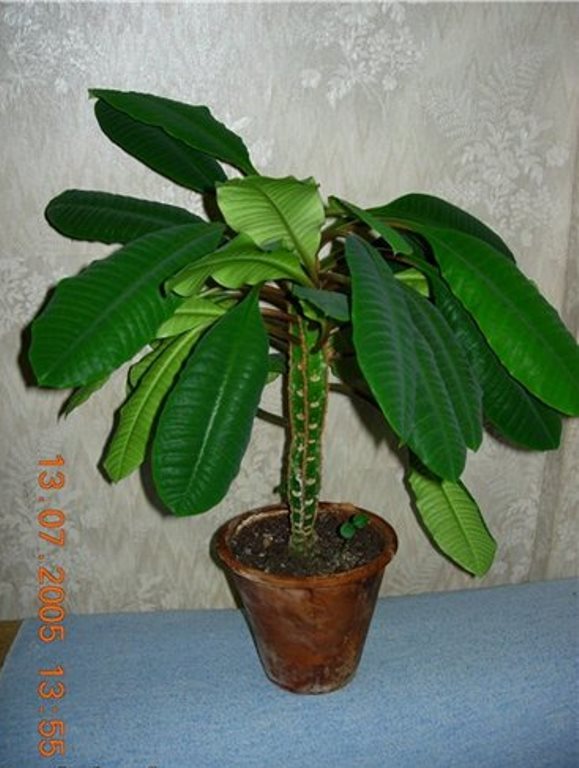

If your spurge was happy with everything, but at some point its leaves curled up and turned yellow or spots appeared on them, then most likely it was attacked by pests. In this case, the plant must be treated with a pest control agent according to the instructions on the package.
Benefit and harm
Knowing about the beneficial properties of this plant, it has been used by traditional healers from time immemorial. All its parts are medicinal - foliage, flowers, sap, stems and even roots. Euphorbia is known as a cure for many diseases.
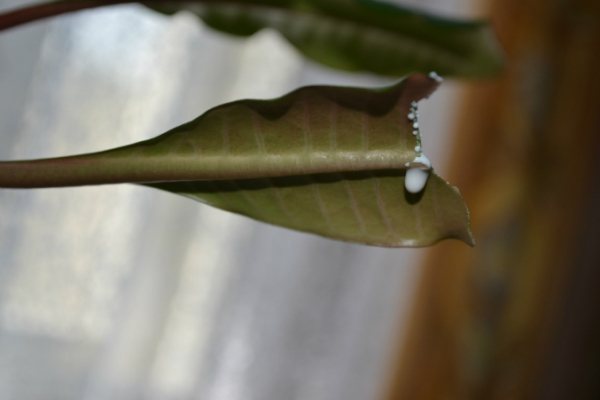

All varieties of milkweed are toxic. Both the stems and the foliage of the plant contain a whitish milky sap, one of which is a highly toxic substance - euphorbin. Therefore, it is necessary to transplant and propagate plants of this species with utmost care.
Important! Experienced gardeners recommend wearing gloves before pruning a plant.A drop of milkweed juice, falling on the skin of a person or animal, can severely burn it. If the juice gets into the eyes, short-term, and in some cases, life-long blindness can occur.
Poisoning with milkweed juice diagnosed by the following symptoms:
- fainting and dizziness;
- nausea;
- disruption of the heart valve;
- paralysis.
Application in traditional medicine
The benefits and harms of this plant in the apartment are constantly contested. It is known that folk healers see a great help for human health in the milky sap of a plant. This whitish and extremely dangerous substance, as it turned out, has a whole bunch of medicinal properties. Milkweed juice is considered an excellent diaphoretic, laxative, and anti-inflammatory agent.
In folk medicine, the plant is known as a medicine for healing slowly healing wounds, heartburn, stomach and kidney diseases, cystitis, hemorrhoids and many other diseases.
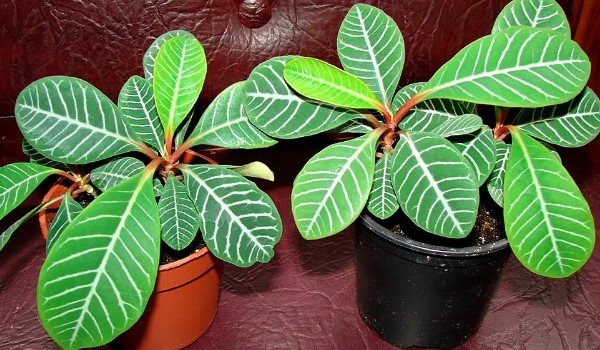

Modern pharmacists use all parts of the plant for the manufacture of medicines, and people who self-medicate prepare alcoholic tinctures and decoctions from white milkweed.
However, according to experts, euphorbia is not a plant through which you can heal yourself. So you can cause irreparable harm to your own health.
Medicines made from milkweed are contraindicated in women during pregnancy and lactation, as well as in children. You should not use the plant as a medicine for heart patients, hypertensive patients and people suffering from pulmonary diseases.
Soil requirements
For the cultivation of this exotic, both a ready-made soil mixture used for palms and succulents, and a self-prepared substrate are suitable. For him, you can take in equal proportions:
- coarse sand, which must first be washed or calcined to eliminate pathogenic microflora;
- peat;
- leafy land, freed from plant roots and debris.
Choose a flat and wide pot as a container for milkweed. This plant has superficial roots that are visible above the ground. They should be above the edge of the pot. Use a drainage layer with a thickness of at least 4 cm for the stability of a sufficiently massive milkweed. In addition, drainage prevents waterlogging of the lower soil layers and moisture stagnation.
There should be drainage holes in the pot, through which excess water will drain into the pan. During the transplantation of adult large plants, in addition to drainage, small stones and large rubble can be placed on the bottom of the pot - they will keep the tree in an upright position.
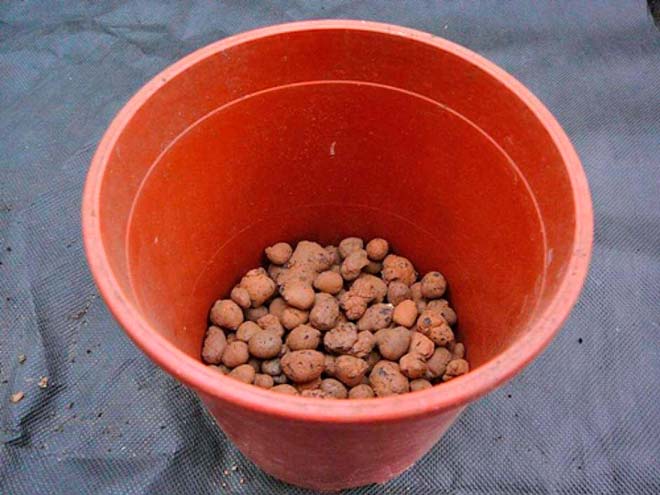

Growing
White-veined euphorbia is propagated both by seeds and vegetatively... The first method is easy to implement and boils down to several important stages:
- Seeds are harvested in autumn and stored in a warm, well-ventilated place.
- In early spring, the seeds are prepared for planting: it is necessary to lightly grind the seed to make it easier for the shoot to break the thick shell and germinate.
- Euphorbia is planted in loosened soil to a depth of 4-5 mm or spread on the soil surface and sprinkled with a thin layer of substrate or sand.
- They create a greenhouse effect for a couple of weeks using a covering material. At this time, the planting is kept in a cool place and periodically sprayed from a spray bottle.
- In the third week, the plant germinates, it must be regularly ventilated.
- Fortified shoots are dived and planted in individual pots.
White milkweed is also suitable for propagation by cuttings:
- In early summer, lateral shoots appear at the base of the plant. They are cut as close to the trunk as possible, sprinkled with wood ash or crushed activated carbon.
- The cut pieces are left alone for several days or kept in warm water.During this time, most of the poisonous juice will be released.
- After a couple of days, the cuttings are planted in soil containing sand and peat. A succulent substrate is best.
- When planting, observe the temperature regime of 20-24 C. The first month the plant should be at rest.
Diseases
Unfortunately, you can't do without them. So, improper care immediately affects the general condition of the flower. For example, a cold snap or abundant watering leads to the appearance of diseases. The first place among them is occupied by various types of rot.
The most common diseases and their causes:
- Gray rot. The main sign of its appearance is a gray-olive bloom on the leaves. Sick processes should be removed immediately, and the incisions should be sprinkled with chalk or wood ash. If this method does not help, you should use a 0.2% solution of "Fundazol" or, as an option, use a soap-copper solution.
- Late blight attacks the roots and slows down growth. Dead roots cannot be treated, but the surviving ones can be saved by using fungicides. For example, such as "Ordana" (5 g per 10 liters of water), "Oksikhom" (10 g per 10 liters) and the stronger "Vitaros" (2 ml per 10 liters).
- The main sign of waterlogging is spotting. When the affected parts of the plant are removed, the entire aerial part must be sprayed with a solution of Vectra (3 ml per 10 l) or copper sulfate (100 g per 10 l of water). Alirin-B, produced in the form of tablets, will also help. You need 2 pieces per liter of water.
Preventive treatments should be carried out in order to prevent the appearance of rot, monitor watering and transplant plants as necessary.
Useful video
We offer you to watch a video about white milkweed and methods of caring for it:
We recommend reading about the care and features of growing other types of milkweed:
- Pallas.
- Perennial garden.
- Cypress.
- Toothed.
- Tirucalli.
- Fat.
- Multi-flowered.
- Bordered.
Poisonous plant burns
The juice that is released from the succulent burns the skin, and if there is an increased sensitivity to its substances, ulcerations appear. The first sign of skin lesions is a burning sensation, the affected area swells, turns red, becomes covered with a rash, and itching bothers.
To reduce unpleasant symptoms or completely eliminate, the following is necessary:
- wash your hands with soap and water;
- apply an anti-burn agent to the damaged area;
- take an antihistamine: Suprastin, Loratadin, Tavegil or another.
The most dangerous situation is the ingress of milky juice on the mucous membrane of the eye. In this case, there is a sharp burning pain, swelling, visual acuity decreases. In the case of euphorbia fluid, temporary blindness may occur. Such a burn leads to inflammation of the conjunctiva. And with extensive damage to the eye, a person can go blind forever.
If the juice gets into your eyes, you should wash your hands with soap and water and rinse your eyes with plenty of water or chamomile broth. You can eliminate pain using antiallergic drugs: Dexamethasone, Maxidex, Allergodil.
Similar ambulance algorithms are suitable if poisoning or burns have occurred with any poisonous plant.
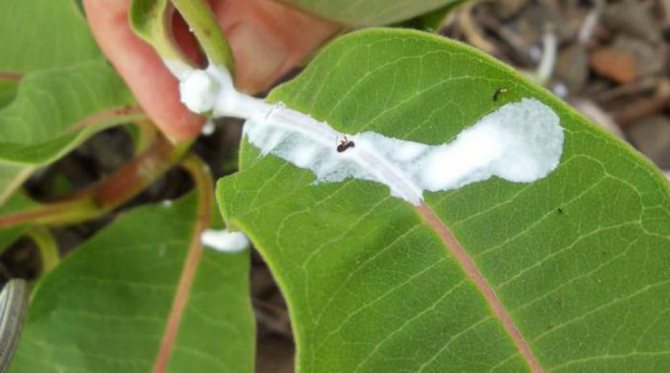

Photo
Further, you can see the euphorbia Belozhilkovy (white-veined) in the photo: Such types of euphorbia are very popular among flower growers as: Multiflorous, Edged, Cypress, Tirukalli, Pallasa, Mila, Trekhgranny.
Photo gallery
In early spring, light green buds with white threadlike petals appear in the leaf axils. The flowers are small and are almost invisible against the background of large, bright foliage.
Around mid-August, the flowering period ends, boxes with seeds ripen in the place of wilted inflorescences. A fully ripe box bursts and literally shoots out seeds, scattering them in a radius of about half a meter.
Important! To prevent the seeds from sprouting in the nearby flowerpots, the box should be removed until it is fully ripe.
Varieties
Garden
Swamp view
It grows in the European part of the country and in the regions of the Far East. Can grow in water
, reaches a meter in length, blooms in May-June. The flower petals are purple.
Glossy
It is found in meadows and fields, at the edges of the forest, blooms in May - July, decoctions are made from leaves and roots, used as a laxative, diuretic and emetic.
Fiery
Perennial shrub, height up to 80 cm, red flowers, blooms in June.
Pallas
Better known as: man-root
, male root. Distributed in the Far East and Transbaikalia, a perennial with lemon flowers, reaches 40 cm.Infusions of this milkweed
used in the treatment of prostatitis, impotence
, used for wound healing and as a tonic.
In addition to the previously listed species, the following types of milkweed are very popular::,.
Lighting
The plant is demanding for light. It develops beautifully on the eastern windows. The risk of exposure to direct sunlight should be minimized, as they can leave burns on the leaves. Constant shadowing is also not desirable. In turn, partial shade is not an obstacle. Ideal when lighting is seasonally adjusted.
In summer, for example, it is best to take the pot out into the garden and cover it from the sun, or place the plant under a tree. In the period from October to March, you can turn on the lamp for several hours. Then, in the spring, a resting euphorbia will delight you with its rapid growth and rich color of leaves. Rotating the pot every day ensures that all areas of the plant are illuminated evenly.
The poisonousness of the plant
Is it possible to keep a pot of milkweed at home, is it poisonous or not? Despite the nondescript appearance and seeming simplicity, it is worth observing a number of precautions when in contact with a flower. It is important not to put the pot with the plant in the nursery and all the work on planting, cropping, etc. carry out in protective gloves. This is due to the fact that all the visible parts of the milkweed secrete juice, which, if it comes into contact with the skin or mucous membrane, causes irritation and burns.
It is necessary to carefully place the spurge next to other plants... After flowering, a capsule is left filled with seeds, which can be scattered up to 4 meters after ripening.
Air
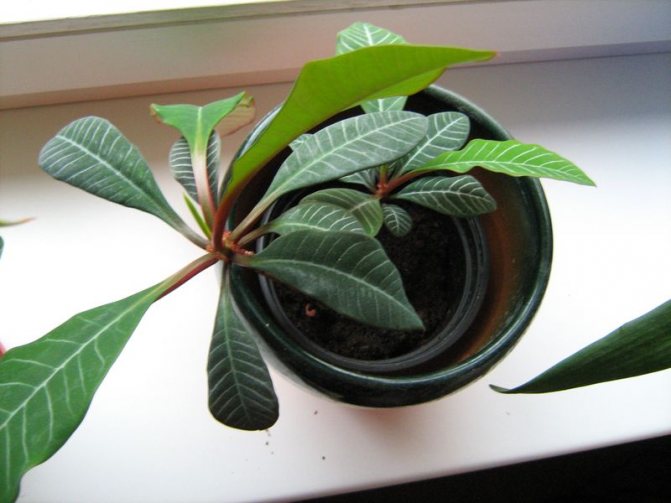

Since this plant is not spoiled by humid air in nature, it perfectly tolerates the neighborhood with heaters or batteries. However, you should not put the pot with it close to the heat source, because this can lead to overdrying of the soil.
In the spring, when it gets warmer, it is necessary to arrange ventilation. A pot with a flower is taken out to the balcony or loggia for a couple of hours. This procedure has a good effect on growth, as it stimulates the movement of cell sap.
Truth and prejudice: yes or no milkweed in the house?
In fact, the extravagance of this plant does not scare away many flower growers, but, on the contrary, attracts attention. And the question of whether it is possible to keep euphorbia in the house does not bother them too much. Actually, there are no categorical statements and prohibitions. However, Feng Shui warns - a number of special requirements are imposed on all prickly and poisonous flowers:
- A cactus and other thorny plant should not be placed in a recreation and marriage area, for example, a bedroom. It is believed that it has a negative effect on intergender relations, and "thorns" can hardly be attributed to the symbols of conception and procreation, rather the opposite. Euphorbia belongs to this category, so this also applies to it.
- Euphorbia is often called the "palm of misfortune" and it is believed that the flower brings negativity into the house. This is partly true, since the toxicity of the succulent can cause accidents, and in addition, this flower often acts as an allergen, worsening the condition of the residents.
- But, the negative characteristics of milkweed can turn into advantages if you find the right place for it. It is believed that the presence of such a plant in the hallway, at some distance from the doors, is a powerful protection and guardian of housing from negative influences. It prevents negative energy from entering the house.
- Euphorbia has no place in the toilet or bathroom - in this case, all positive energy will leak with water, and the negative will remain.
- Succulents are not recommended to be placed near water, nevertheless, these are desert inhabitants. There is a belief that such an arrangement of a flower in a house leads to the development of chronic diseases in residents.
- Euphorbia is not suitable for children's rooms - playrooms and bedrooms. He has a feng shui energy that can negatively affect children. And besides, there are well-founded reasons why the plant should not be placed in such rooms - it has poisonous sap, which can cause burns or poisoning, and prickly parts that can cause injury.
- The peak of the magical power of many plants is during the flowering period. At this time, the succulent plant can be placed in the living room; it will also become an excellent interior decoration that arouses the envy and admiration of guests. However, when the process is complete and the flowers have fallen off, it is advisable to put the flower somewhere else.


The main signs and superstitions associated with indoor vegetation are associated with their death. For example, if a flower dies, it is believed that it saved people from misfortune, prevented trouble. However, growers believe that diseases and pests, or poor care, are to blame.
Another dubious belief has ruined more than one beautiful plant, it says that a stolen flower takes root much better. But, a barbarously separated stalk or a roughly torn off shoot, in a period not suitable for plant reproduction, can greatly harm it and even cause death.
So, not all superstitions of plant breeders approve and you can leave euphorbia as a houseplant, not forgetting about precautions. Poisonous succulent in the house: precautions and features Such an unusual home flower needs a special approach and adherence to certain rules:
- it is forbidden to prepare medicines from milkweed or other poisonous plant at home; parts of flowers emit harmful substances that can cause poisoning;
- you can not take or use traditional medicines that include this component without first consulting a doctor;
- if there are animals in the house that can get to a dangerous plant, you should think about whether you need to risk it;
- during events related to the care of a succulent, do not neglect protective equipment - you should only touch it with gloves.

